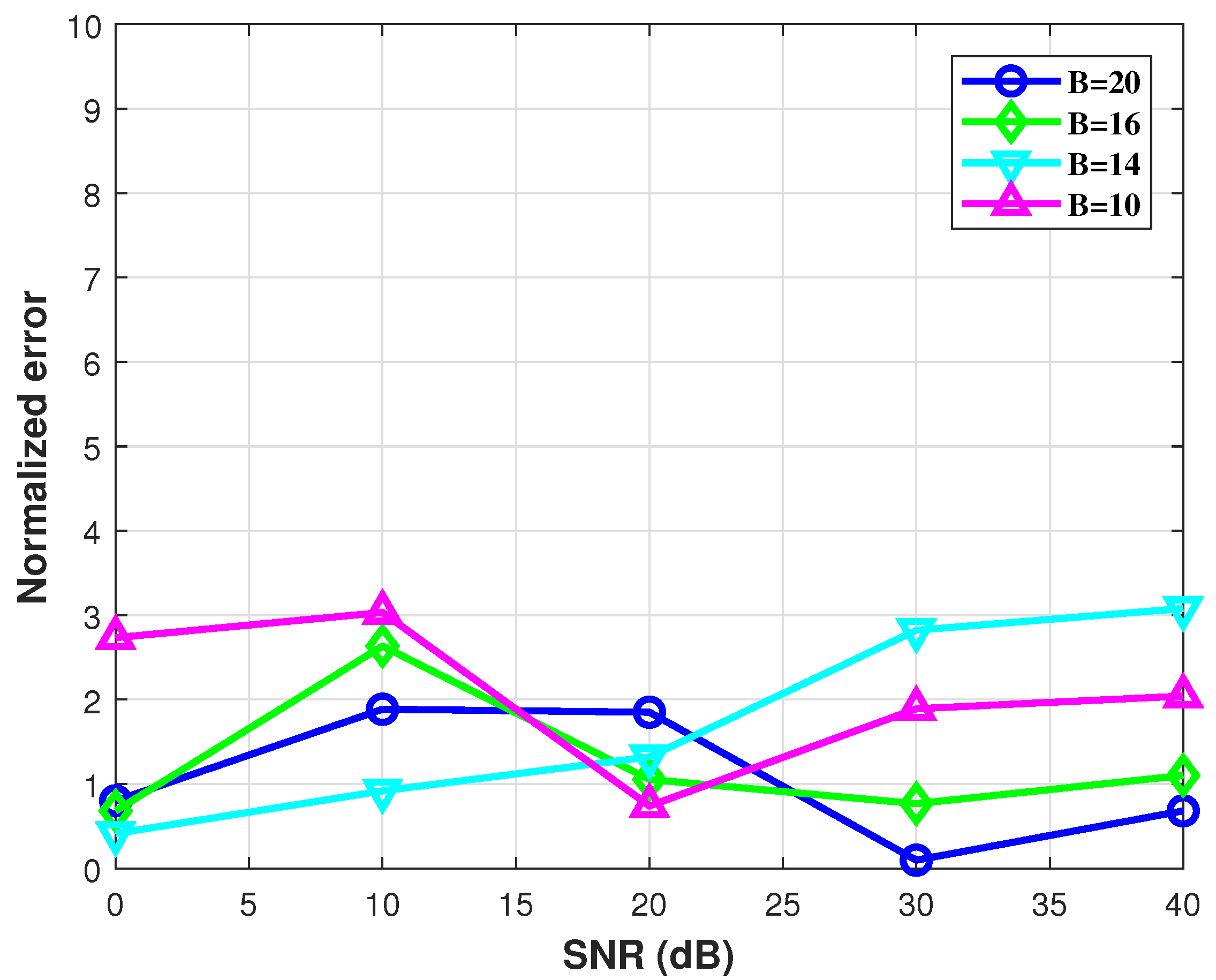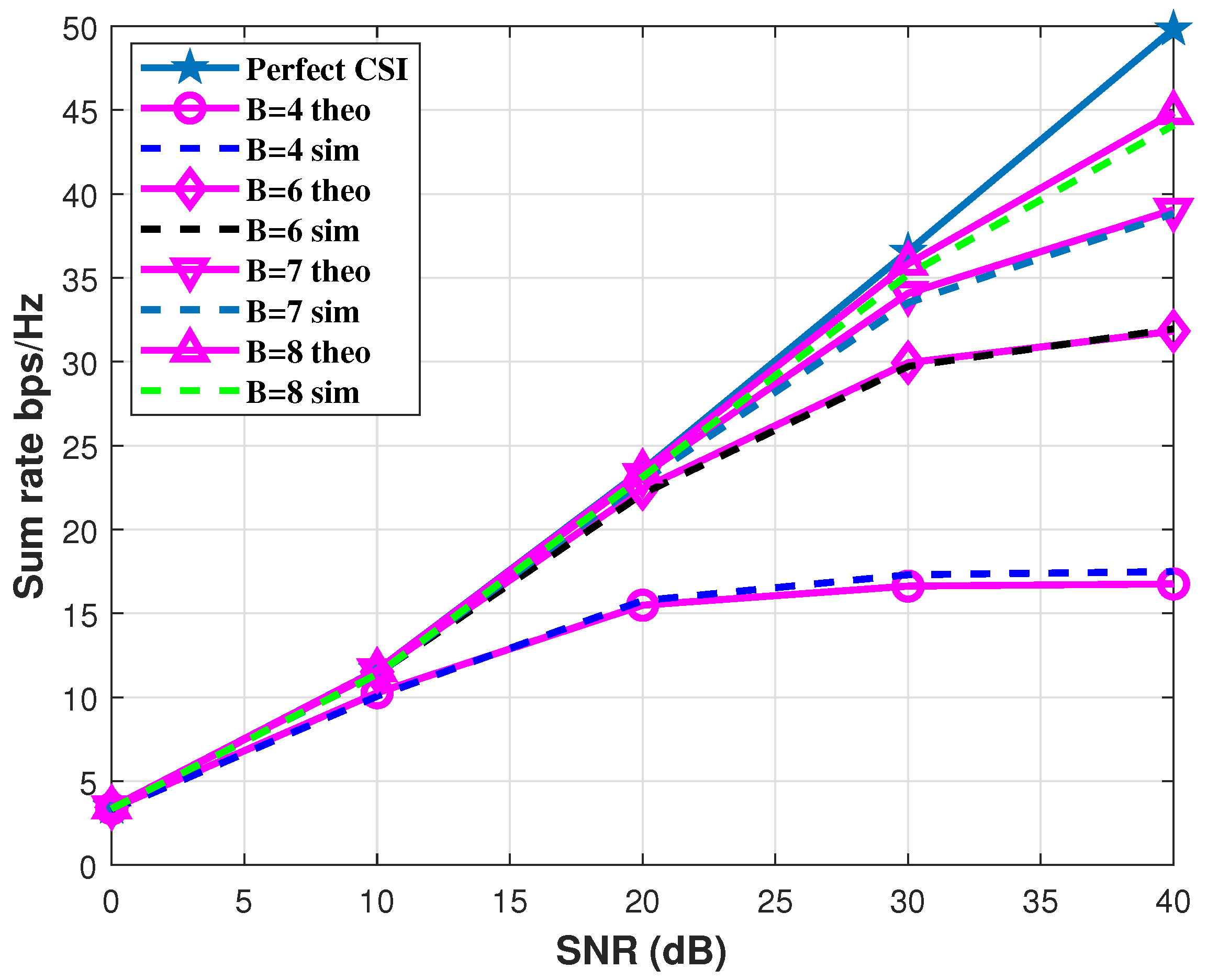Closed-Form Sum-Rate Analysis of Interference Alignment with Limited Feedback Based on Scalar Quantization and Random Vector Quantization
Abstract
:1. Introduction
2. System Model
- Forward link training and estimation: All K transmitters take turns to broadcast the training symbols. The training matrix for transmitter is denoted by , where is the number of training symbols. Thus, the received signal at receiver can be represented bywhere P is the transmit power, denotes the channel matrix between and , and is the Gaussian noise vector. It is assumed that represents the uncorrelated Rayleigh small-scale fading channel, i.e., the elements of are independently and identically distributed (i.i.d.) according to . The simplest training matrix is the identity matrix . It is assumed that can perfectly estimate ;
- Channel quantization: quantizes the estimated channel matrix as ;
- Quantized channel index feedback: feeds back the quantized information of interference channels via the reverse channel. All the K receivers take turns to feed back, and then each transmitter can receive quantized channel matrices;
- IA solution computation: It is assumed that each transmitter computes its own IA precoder and decoder. computes precoding matrix and decoding matrix ,where is the transmitted data stream number for transceiver pair and . For simplicity, the symmetric IC scenario is considered in this paper, and thus holds for all transceiver pairs. Except for some special cases, the IA precoding and decoding matrices are determined via iterative methods [30];
- Quantization and feedback of decoders: To inform of its decoding filter, quantizes as and broadcasts it;
- Concurrent data transmission: All transmitters send their desired signals simultaneously. Then, the received signal at can be represented bywhere is the desired signal from to .
3. Sum-Rate Performance with RVQ-Based CSI Feedback
3.1. Vector Quantization of Channel Matrix
3.2. Similarity between RVQ Error and Gaussian Channel Error
4. Sum-Rate Performance with SQ-Based CSI Feedback
4.1. Achievable Sum-Rate with SQ-Based CSI Feedback
4.2. Complexity Comparison of RVQ and SQ
5. Sum-Rate Performance with SQ-Based CSI Feedback and RVQ-Based DI Feedback
6. Simulation Results
6.1. RVQ-Based CSI Feedback
6.2. SQ-Based CSI Feedback
6.3. SQ-Based CSI Feedback and RVQ-Based DI Feedback
7. Conclusions
Author Contributions
Funding
Institutional Review Board Statement
Informed Consent Statement
Data Availability Statement
Acknowledgments
Conflicts of Interest
Abbreviations
| IA | Interference alignment |
| MIMO | Multi-input multi-output |
| DoF | Degree of freedom |
| IC | Interference channel |
| CSI | Channel state information |
| DI | Decoding information |
| VQ | Vector quantization |
| SQ | Scalar quantization |
| RVQ | Random vector quantization |
| SNR | Signal-to-noise ratio |
| LFB | Limited feedback |
| CDF | Cumulative distribution function |
| Probability distribution function | |
| FLOP | Floating-point operation |
Appendix A
References
- Jafar, S.A. Interference alignment: A new look at signal dimensions in a communication network. Found. Trends® Commun. Inf. Theory 2011, 7, 1–134. [Google Scholar]
- Li, S.; Zhao, D.; Wang, Y.; Ye, W.; Liu, J.; Huang, T. Adaptive Strategy of General Centralized Feedback Model for Interference Alignment in Asymmetric Interference Networks. IEEE Trans. Commun. 2019, 67, 2517–2526. [Google Scholar] [CrossRef]
- Ayach, O.E.; Peters, S.W.; Heath, R.W. The practical challenges of interference alignment. IEEE Wirel. Commun. 2013, 20, 35–42. [Google Scholar] [CrossRef] [Green Version]
- Ayach, O.E.; Lozano, A.; Heath, R.W. On the Overhead of Interference Alignment: Training, Feedback, and Cooperation. IEEE Trans. Wirel. Commun. 2012, 11, 4192–4203. [Google Scholar] [CrossRef]
- Gray, R.; Neuhoff, D. Quantization. IEEE Trans. Inf. Theory 1998, 44, 2325–2383. [Google Scholar] [CrossRef]
- Huang, P.; Pi, Y. A Novel MIMO Channel State Feedback Scheme and Overhead Calculation. IEEE Trans. Commun. 2018, 66, 4550–4562. [Google Scholar] [CrossRef]
- Min, M.; Jeon, Y.S.; Im, G.H. On Achievable Rate of User Selection for MIMO Broadcast Channels With Limited Feedback. IEEE Trans. Commun. 2017, 65, 122–135. [Google Scholar] [CrossRef]
- Cui, Q.; Wang, H.; Hu, P.; Tao, X.; Zhang, P.; Hamalainen, J.; Xia, L. Evolution of Limited-Feedback CoMP Systems from 4G to 5G: CoMP Features and Limited-Feedback Approaches. IEEE Veh. Technol. Mag. 2014, 9, 94–103. [Google Scholar] [CrossRef]
- Özbek, B.; Le Ruyet, D. Feedback Strategies for Wireless Communication; Springer: Berlin/Heidelberg, Germany, 2014. [Google Scholar]
- Asplund, H.; Astely, D.; von Butovitsch, P.; Chapman, T.; Frenne, M.; Ghasemzadeh, F.; Hagström, M.; Hogan, B.; Jongren, G.; Karlsson, J.; et al. Advanced Antenna Systems for 5G Network Deployments: Bridging the Gap Between Theory and Practice; Academic Press: Cambridge, MA, USA, 2020. [Google Scholar]
- Jindal, N. MIMO Broadcast Channels With Finite-Rate Feedback. IEEE Trans. Inf. Theory 2006, 52, 5045–5060. [Google Scholar] [CrossRef] [Green Version]
- Thukral, J.; Bolcskei, H. Interference alignment with limited feedback. In Proceedings of the 2009 IEEE International Symposium on Information Theory, Seoul, Korea, 28 June–3 July 2009; pp. 1759–1763. [Google Scholar] [CrossRef] [Green Version]
- Krishnamachari, R.T.; Varanasi, M.K. Interference Alignment Under Limited Feedback for MIMO Interference Channels. IEEE Trans. Signal Process. 2013, 61, 3908–3917. [Google Scholar] [CrossRef]
- Xie, B.; Li, Y.; Minn, H.; Nosratinia, A. Interference Alignment under Training and Feedback Constraints. In Proceedings of the 2011 IEEE Global Telecommunications Conference—GLOBECOM 2011, Houston, TX, USA, 5–9 December 2011; pp. 1–6. [Google Scholar] [CrossRef] [Green Version]
- Chen, X.; Yuen, C. Performance Analysis and Optimization for Interference Alignment Over MIMO Interference Channels With Limited Feedback. IEEE Trans. Signal Process. 2014, 62, 1785–1795. [Google Scholar] [CrossRef] [Green Version]
- Wang, H.; Song, R.; Leung, S. Throughput Analysis of Interference Alignment for a General Centralized Limited Feedback Model. IEEE Trans. Veh. Technol. 2016, 65, 8775–8781. [Google Scholar] [CrossRef]
- Cho, S.; Huang, K.; Kim, D.; Seo, H. Interference Alignment for Uplink Cellular Systems with Limited Feedback. IEEE Commun. Lett. 2012, 16, 960–963. [Google Scholar] [CrossRef]
- Kim, M.; Lee, H.; Ko, Y. Limited Feedback Design for Interference Alignment on Two-Cell Interfering MIMO-MAC. IEEE Trans. Veh. Technol. 2015, 64, 4019–4030. [Google Scholar] [CrossRef]
- Cao, P.; Zappone, A.; Jorswieck, E.A. Grouping-Based Interference Alignment with IA-Cell Assignment in Multi-Cell MIMO MAC Under Limited Feedback. IEEE Trans. Signal Process. 2016, 64, 1336–1351. [Google Scholar] [CrossRef] [Green Version]
- Mosleh, S.; Ashdown, J.D.; Matyjas, J.D.; Medley, M.J.; Zhang, J.; Liu, L. Interference Alignment for Downlink Multi-Cell LTE-Advanced Systems With Limited Feedback. IEEE Trans. Wirel. Commun. 2016, 15, 8107–8121. [Google Scholar] [CrossRef]
- Tresch, R.; Guillaud, M. Cellular Interference Alignment with Imperfect Channel Knowledge. In Proceedings of the 2009 IEEE International Conference on Communications Workshops, Dresden, Germany, 14–18 June 2009; pp. 1–5. [Google Scholar] [CrossRef]
- Razavi, S.M.; Ratnarajah, T. Performance Analysis of Interference Alignment Under CSI Mismatch. IEEE Trans. Veh. Technol. 2014, 63, 4740–4748. [Google Scholar] [CrossRef]
- Castanheira, D.; Silva, A.; Gameiro, A. Retrospective Interference Alignment for the K -User M × N MIMO Interference Channel. IEEE Trans. Wirel. Commun. 2016, 15, 8368–8379. [Google Scholar] [CrossRef]
- Su, X.; Yuan, Y.; Wang, Q. Performance Analysis of Rate Splitting in K-User Interference Channel Under Imperfect CSIT: Average Sum Rate, Outage Probability and SER. IEEE Access 2020, 8, 136930–136946. [Google Scholar] [CrossRef]
- El Ayach, O.; Heath, R.W. Grassmannian Differential Limited Feedback for Interference Alignment. IEEE Trans. Signal Process. 2012, 60, 6481–6494. [Google Scholar] [CrossRef]
- Garg, N.; Jagannatham, A.K.; Sharma, G.; Ratnarajah, T. Precoder Feedback Schemes for Robust Interference Alignment With Bounded CSI Uncertainty. IEEE Trans. Signal Inf. Process. Over Netw. 2020, 6, 407–425. [Google Scholar] [CrossRef]
- Peng, S.; Lu, W.; Zhong, L.; Kong, Z. Spatial Interference Alignment Relying on Limited Precoding Matrix Feedback Indices. In Proceedings of the 2020 IEEE 91st Vehicular Technology Conference (VTC2020-Spring), Antwerp, Belgium, 25–28 May 2020; pp. 1–5. [Google Scholar] [CrossRef]
- Kang, J.; Choi, W. Novel Codebook Design for Channel State Information Quantization in MIMO Rician Fading Channels With Limited Feedback. IEEE Trans. Signal Process. 2021, 69, 2858–2872. [Google Scholar] [CrossRef]
- Ma, J.; Zhang, S.; Li, H.; Gao, F.; Han, Z. Time-Varying Downlink Channel Tracking for Quantized Massive MIMO Networks. IEEE Trans. Wirel. Commun. 2020, 19, 6721–6736. [Google Scholar] [CrossRef]
- Gomadam, K.; Cadambe, V.R.; Jafar, S.A. A Distributed Numerical Approach to Interference Alignment and Applications to Wireless Interference Networks. IEEE Trans. Inf. Theory 2011, 57, 3309–3322. [Google Scholar] [CrossRef]
- Hunger, R. Floating Point Operations in Matrix-Vector Calculus; Munich University of Technology, Inst. for Circuit Theory and Signal Processing: Munich, Germany, 2005. [Google Scholar]
- Khan, Z.; Gulistan, M.; Kausar, N.; Park, C. Neutrosophic Rayleigh Model With Some Basic Characteristics and Engineering Applications. IEEE Access 2021, 9, 71277–71283. [Google Scholar] [CrossRef]
- Aslam, M.; Azam, M.; Albassam, M. Sampling Plan Using Process Loss Index Using Multiple Dependent State Sampling Under Neutrosophic Statistics. IEEE Access 2019, 7, 38568–38576. [Google Scholar] [CrossRef]
- Aslam, M. Design of Sampling Plan for Exponential Distribution Under Neutrosophic Statistical Interval Method. IEEE Access 2018, 6, 64153–64158. [Google Scholar] [CrossRef]
- Aslam, M. Analyzing wind power data using analysis of means under neutrosophic statistics. Soft Comput. 2021, 25, 7087–7093. [Google Scholar] [CrossRef]














Publisher’s Note: MDPI stays neutral with regard to jurisdictional claims in published maps and institutional affiliations. |
© 2022 by the authors. Licensee MDPI, Basel, Switzerland. This article is an open access article distributed under the terms and conditions of the Creative Commons Attribution (CC BY) license (https://creativecommons.org/licenses/by/4.0/).
Share and Cite
Suo, L.; Liu, F. Closed-Form Sum-Rate Analysis of Interference Alignment with Limited Feedback Based on Scalar Quantization and Random Vector Quantization. Appl. Sci. 2022, 12, 6117. https://doi.org/10.3390/app12126117
Suo L, Liu F. Closed-Form Sum-Rate Analysis of Interference Alignment with Limited Feedback Based on Scalar Quantization and Random Vector Quantization. Applied Sciences. 2022; 12(12):6117. https://doi.org/10.3390/app12126117
Chicago/Turabian StyleSuo, Long, and Fei Liu. 2022. "Closed-Form Sum-Rate Analysis of Interference Alignment with Limited Feedback Based on Scalar Quantization and Random Vector Quantization" Applied Sciences 12, no. 12: 6117. https://doi.org/10.3390/app12126117
APA StyleSuo, L., & Liu, F. (2022). Closed-Form Sum-Rate Analysis of Interference Alignment with Limited Feedback Based on Scalar Quantization and Random Vector Quantization. Applied Sciences, 12(12), 6117. https://doi.org/10.3390/app12126117





